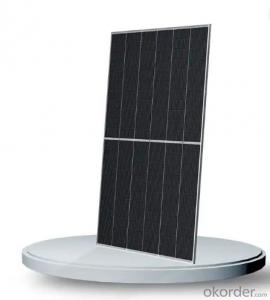Monocrystalline Bifacial Double Glass Half Cut Cell Solar Panel Perc Module for Solar System NCQ
- Loading Port:
- SHANGHAI
- Payment Terms:
- TT OR LC
- Min Order Qty:
- 10 pc
- Supply Capability:
- 100 pc/month
OKorder Service Pledge
OKorder Financial Service
You Might Also Like
Item specifice
Ø OPERATING PARAMETERSOPERATIN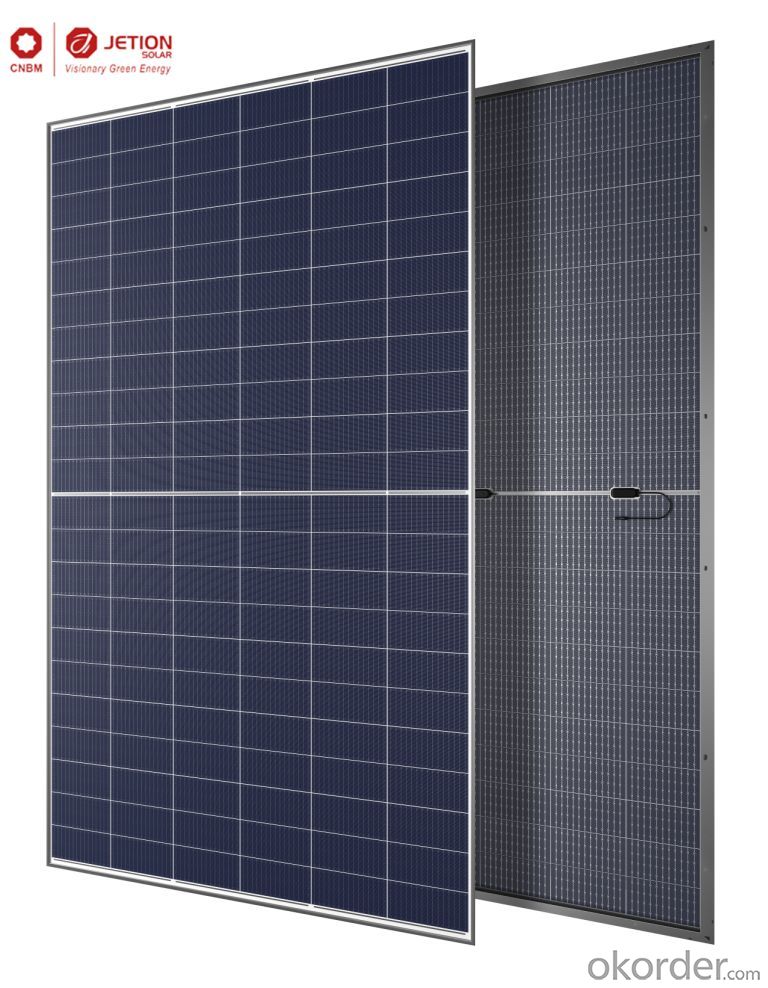
Maximum System Voltage | 1500V/DC(IEC) |
Operating Temperature | -40°C-+85°C |
Maximum Series Fuse | 35A |
Maximum Test Load,Push/Pull | 5400Pa/2400Pa |
Conductivity at Ground | ≤ 0.1Ω |
Safety Class | Ⅱ |
Resistance | ≥100MΩ |
Voc and Isc Tolerance | ±3% |
Bifaciality | 80±5% |
Ø MECHANICAL DATA
Solar Cell Type | Mono 210×105 mm(8.3×4.1 inches) |
Number of Cells | 132 [2 x (11 x 6) ] |
Module Dimensions | 2384×1303×35 mm(93.9×51.3×1.4 inches) |
Weight | 38.7 kg(85.3 lb) |
Front Cover | High transmission, AR coated tempered glass, 2.0mm |
Back Cover | High transmission, Tempered, White Grid Glass/AR coating(optional), 2.0mm |
Frame | Silver, anodized aluminium alloy |
J-Box | ≥IP68 |
Cable | 4.0 mm2 solar cable, ≥300 mm(11.8 inches)/customizable |
Number of diodes | 3 |
Connector | MC4 EVO2 compatible |
Ø PACKAGING CONFIGURATION
Module per pallet :31 pieces
Module per 40'HQ container: 17 pallets, 527 pieces
Ø QUALIFICATIONS & CERTIFICATES
ü IEC 61215, IEC 61730
ü ISO 9001: Quality Management System
ü ISO 14001: Environment Management System
ü ISO 45001: Occupational Health and Safety
ü IEC 62941: Design and Manufacture of Crystalline Silicon Photovoltaic Modules
Ø JETION SOLAR
As a member of CNBM - a Fortune 500 company, Jetion Solar provides various product solutions, global EPC service and financing. Its standard and high- efficiency product offerings are among the most powerful and cost-effective in the industry. Till now, Jetion Solar has cumulatively more than 10 GW module shipment and 1 GW global EPC track records.
Installation instruction must be followed.See the installation manual or contact our technical service department for further information on approved installation.
The specification and key features described in this data sheet may deviate slightly and are not guaranteed. Due to ongoing innovation, R&D enhancement, Jetion.
Solar (China) Co., Ltd. reserves the right to make any adjustment to the information described herein at any time without notice. Please always obtain the most.
recent version of the data sheet which shall be duly incorporated into the binding contract made by the parties governing all transactions related to the purchase and sale of the products described herein.
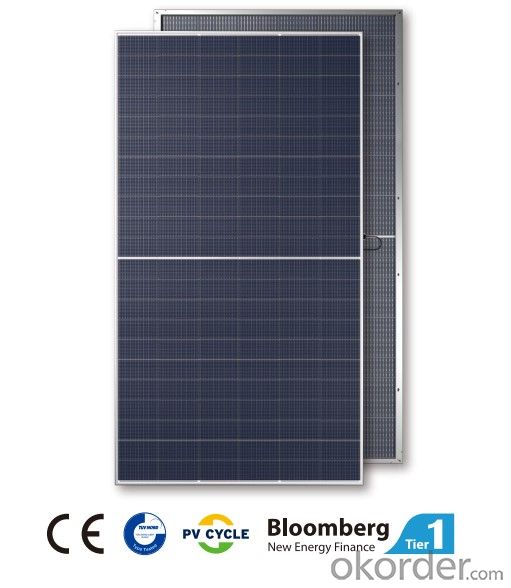
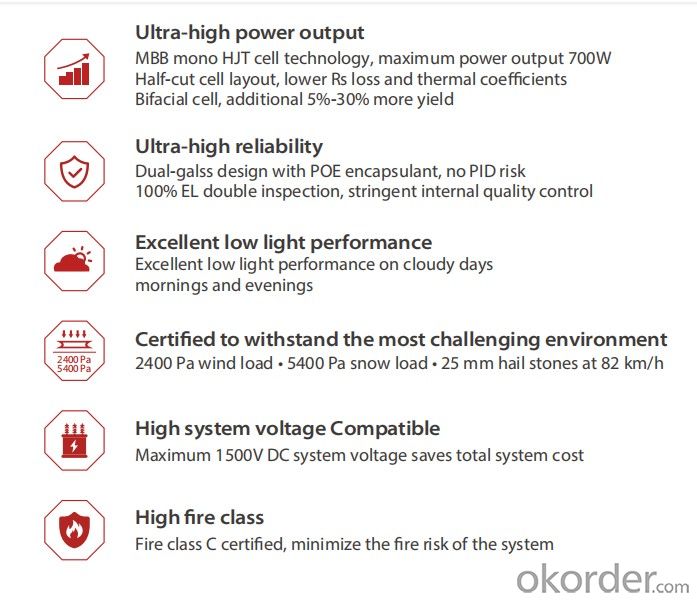
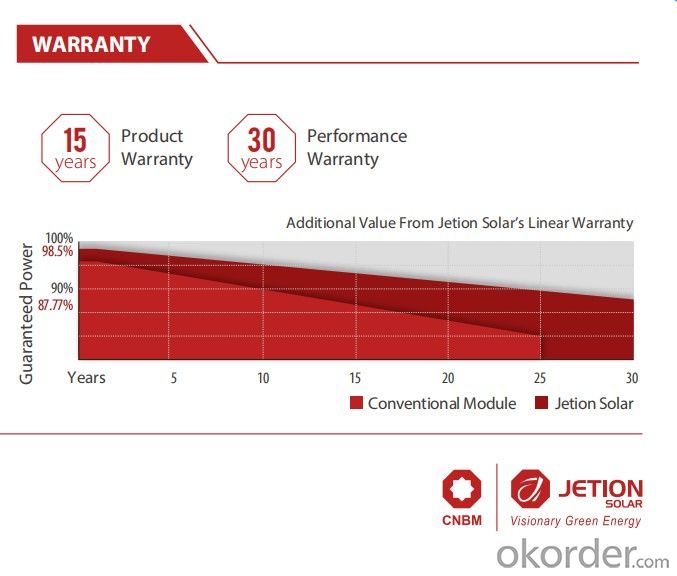
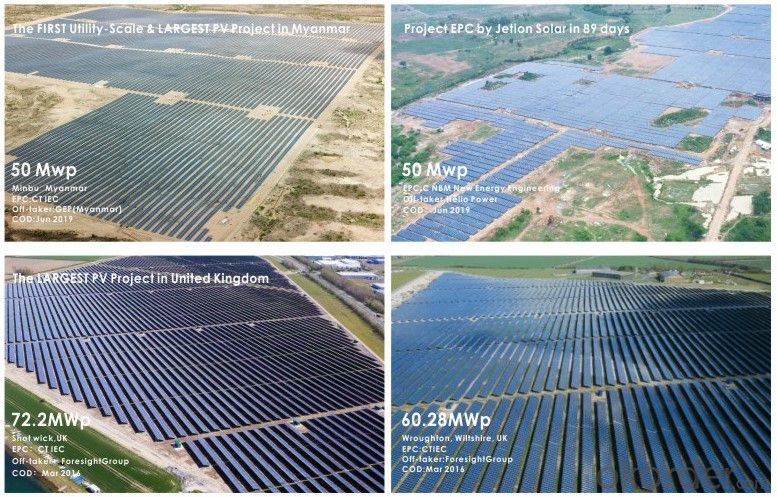
Ø FAQ
Q:How can we guarantee the products quality?
A:Always provide the esteemed buyer a pre-production sample before mass production; Always testing every product before despatching the shipments;
Q:What products we can supply you?
A:Solar Panel,Inverter,Mounting System,Battery,PV Cable,Distributor Box,Pv Connector,Etc
Q:Where is your Manufacturer located? How can I visit there?
A:Our factory located in 501, Building 1, No. 600, Tongjiang Middle Road, Changzhou City, Jiangsu Province,China
Q:Can the products pricing be cheaper?
A:Of course, you will be offered a a very good discount with large quantities.
Q: Can print our company‘s logo on the PV panels?
A:Yes! And we accept the OEM&ODM orders.
- Q:Can solar panels be installed in rural areas?
- Yes, solar panels can be installed in rural areas. In fact, rural areas often have more space and sunlight, making them ideal for solar energy generation. Installing solar panels in rural areas can provide access to clean and renewable energy, reduce reliance on fossil fuels, and bring electricity to remote communities that are not connected to the grid.
- Q:Can solar panels be installed on airports or transportation hubs?
- Yes, solar panels can be installed on airports or transportation hubs. In fact, many airports and transportation hubs around the world have already implemented solar panel systems to generate clean and renewable energy. These installations not only help reduce the carbon footprint of these facilities but also contribute to their energy self-sufficiency and cost savings.
- Q:How do solar panels affect roof warranty?
- Solar panels can potentially affect roof warranty, as their installation involves drilling holes into the roof and attaching the panels. This may void certain aspects of the roof warranty, especially those related to leaks or damage caused by the installation. It is important to review the terms of the roof warranty and consult with a professional installer to understand the specific impact solar panels may have on the warranty.
- Q:I need to build a battery array to use with my solar panels I just bought. I want to be able to store enough energy to be draw from it at night, possibly around the clock. Is there a down side to using the deep cycle battery I bought from autozone and 6 or 7 more just like it, or do I need to get some other battery?
- There are batteries particularly made for solar, such as the Trojan T05-RE . I think the RE stands for renewable energy. A deep cycle battery should work all right, although not quite as well. What you want to do is try out your setup first, with just one battery, and the panels provided. If this is one of those 45 watt kits, you may be surprised at how little energy you actually get from the panels. Increasing the number of batteries won't help, either - that's like getting a larger water tank, when you only have a trickle to fill it. If your goal is really to save money, the most cost-effective solar is the grid-tied type, with no batteries at all. That's what we have, and I've never regretted it.
- Q:I want to use this solar panel to hook up AC adapters. IM not sure what to do and how to use the solar panel. I want to be able to use a batter charger, a radio, and charge a GPS if needed. - Thanks, Zoo
- You will need a charger controller, a 2 volt battery and a inverter to convert the 2volt dc to 20 volt ac. Your also going to need about 0 more solar panels of the same size!
- Q:How do solar panels affect the homeowner's insurance policy?
- Solar panels can have an impact on a homeowner's insurance policy as they are considered an additional structure or improvement to the property. While they may increase the overall value of the home, they also introduce potential risks such as damage from storms or accidents. Homeowners should inform their insurance provider about the installation of solar panels to ensure adequate coverage and potentially adjust their policy accordingly.
- Q:Any recommendations for companies? Any things to look out for?
- It depends upon how you look at things. If you are looking for a decent return on investment, or a business decision, it is probably very unwise. In most cases people would see a far better return in upgrading insulation in ceilings, walls, and windows to much better insulation than they currently have, followed by proper resizing heating and air conditioning to smaller unit size to fit their lesser need as a result of the insulation. The heat an air conditioning units should be the highest efficiency available. The return on the above can make a positive and economic investment in many cases. If you have done the above first, and have money to spend and do not care about the return on it, then you can play with solar or wind. However, typical cost of generation of solar and wind energy is about $0.22 / KWH and you can purchase from utility at about $0.0/ KWH including generation and distribution so this is not all that prudent.
- Q:I am curious about how much of the energy that a solar panel of a given size and capacity will produce in it's lifetime, and what fraction of that energy was required to produce it in the first place?
- The attached link is to an article from the 200 Home Power magazine. In that article the energy payback was found to be between 2 and 4 years. Newer panels are more efficient primarily because the silicon wafers used today are thinner. The silicon cell embodies most of the energy required to make a solar panel. Today most solar panels will produce the amount of energy required to manufacture them in between about 9 months and 2 years depending upon the specific technology used to make it. Solar panels are expected to produce energy for between 30 and 50 years. Therefore it takes around 5% of their total energy production to produce them. Note that these figures depend upon where the panels are installed. Panels in very sunny areas may generate more than 3 times the energy of panels in a cloudier area. Edit - The energy payback meta-study that carbonates references below mention one particular study Alsema (2000), which the authors used as a baseline to come up with their 4 year payback figure. These studies DO NOT assume ideal conditions. The Alsema study assumes an annual an irradiation of 700 kWh/m2/yr. That is the United States average irradiation and does take into account cloudy weather and the like. Under idea conditions the amount of energy collected can be almost twice as much. Albuquerque New Mexico is an example. The figures I mentioned above are recent values reported by several different panel manufacturers with whom I discussed the issue at the 2006 IEEE 4th World Conference on Photovoltaic Energy Conversion held this May. The very long payback times that carbonate highlights are almost certainly wrong. The study he references concludes that paybacks range between 2 and 8 years with 4 years being the most likely. In my opinion payback times are actually a fair bit shorter based on conversations with the manufacturers.
- Q:Can solar panels be used in areas with high levels of pollution from industrial activities?
- Yes, solar panels can be used in areas with high levels of pollution from industrial activities. While pollution can have some impact on the efficiency of solar panels, they are still able to generate electricity even in polluted areas. Regular cleaning and maintenance of the panels may be required to ensure optimal performance. Additionally, installing solar panels in such areas can help offset some of the carbon emissions from industrial activities, contributing to a cleaner and more sustainable energy future.
- Q:I know that the Solar panels store the power from the sun in the daytime, where does that stored energy go from there? Is it stored in the batteries? And how would you keep the batteries topped up if you had no Electric? by a generator? interested in solar panels for abroad, but need more info.
- Solar panels do not store power. Solar panels convert sunlight into electricity. To store power you need batteries. The usual type of batteries used are lead-acid deep discharge( similar to car batteries). The batteries are charged up during the time the sun is out. However, as a backup you could also have a generator handy to provide power for times when the sun did not shine enough to keep the batteries charged up.
1. Manufacturer Overview |
|
|---|---|
| Location | |
| Year Established | |
| Annual Output Value | |
| Main Markets | |
| Company Certifications | |
2. Manufacturer Certificates |
|
|---|---|
| a) Certification Name | |
| Range | |
| Reference | |
| Validity Period | |
3. Manufacturer Capability |
|
|---|---|
| a)Trade Capacity | |
| Nearest Port | |
| Export Percentage | |
| No.of Employees in Trade Department | |
| Language Spoken: | |
| b)Factory Information | |
| Factory Size: | |
| No. of Production Lines | |
| Contract Manufacturing | |
| Product Price Range | |
Send your message to us
Monocrystalline Bifacial Double Glass Half Cut Cell Solar Panel Perc Module for Solar System NCQ
- Loading Port:
- SHANGHAI
- Payment Terms:
- TT OR LC
- Min Order Qty:
- 10 pc
- Supply Capability:
- 100 pc/month
OKorder Service Pledge
OKorder Financial Service
Similar products
New products
Hot products
Related keywords
